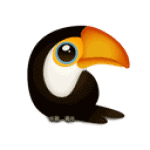A cockatiel is a comical, curious and oftentimes feisty little bird. Known as one of the most popular companion birds in America, they can live up to 25 years of age in captivity. You also can read our article on What is the Average Age of a Cockatiel. They are native to Australia and are related to the cockatoo family.
Determining the cockatiel’s age is partially detective work and mostly a mystery. There are some telltale signs that can help reveal whether it is a baby, juvenile or mature bird. Of course, all birds vary slightly in appearance and the cockatiel age may still be a guess.
The following are some hints to give clues to the approximate age:
- A young bird’s feet will be smooth. The claws will not have any irregularities and there will be no scales. An older bird will have more scales with maybe some cracks or bumps and overgrown nails that bend inward. Sometimes darker leg color will indicate the cockatiel’s age is a bit advanced.
- The feathers of a young bird are smooth against its body and look well groomed and vibrant. The overall condition of the feathers will portray the wear and tear of age.
- The cockatiel is the only small parrot with a head crest. The crest in mature birds is longer with a slight bending curve while, in contrast, it is short and straight in a young bird.
- Baby birds have a large eye-size and its appearance becomes smaller as time passes. Many birds start off with dark-colored irises that can get lighter over time due to cataracts.
- The tail feathers will begin to get longer at about the age of one. Before that, it is approximately the same length as the body.
- Beak size appears bigger because the side feathers are short in a young bird. The base of the beak has nerves and blood supply. However, the beak of an older bird seems somewhat slender and long because it is hidden by side feathers. An older bird generally will have a worn and scuffed beak. The color is also an indication of their age and this will subtly change over time to a slightly darker grey. This may not apply to some mutations.
- As in all young species, the activity level is usually very high. The bird will hop and fly around with a lot of energy. This motion typically lessens with age and an older bird may become more sluggish or lethargic. As cockatiels age, they sleep much longer than young ones, sometimes up to 18 hours a day.
The average age of a cockatiel is determined by many factors.
So how do cockatiels age?
Birds experience a lot of the same changes that humans and other species do as they grow older. This includes mental as well as physical issues. Most physical changes for a cockatiel will occur during the first two years. The Cockatiel age is easier to determine during this time.
Cockatiels are weaned around ten weeks of age and usually not sold until about four months old. The first molt is at approximately six months wherein the males change the color on the bottom of their flight feathers and the color on their cheeks. This means that their baby feathers are changing to adult feathers. Before that, both males and females have relatively the same appearance. This first molt usually is very slow and a few tiny baby feathers may still appear until the baby cockatiel is between one to two years old. Adolescence also begins about this time. Females become more muted in color. Males start to practice their courting behaviors by strutting and hopping. Breeding should not occur before 18-24 months. The female will build a nest or start burrowing to lay her eggs.
Interestingly, the male bird is very protective of his family. He will not abandon them and will step in to care for the young with nurturing affection. Even though the female is responsible for hatching the eggs and caring for the babies, the male will assume the parenting duties if necessary. Generally, cockatiels are known to mate for life as pair bonding is very strong in this species.
What is the cockatiel age when it starts to vocalize?
If you have patiently been teaching your cockatiel to talk, the usual age for vocalization is about eight months. Male birds are more inclined to talk than female. Typically, these cheery little birds are whistlers. They also have a range of soft chirps, cheeps and sharp cries. While all birds make noise, females tend to be a little quieter. Cockatiels are native to the wide-open plains of the semi-arid region of Australia. Therefore, they communicate with whistles and softer sounds. Parrots originating from dense forest habitats have a piercing scream.
How do you feed and care for a cockatiel as it ages?
Wild cockatiels fly down to the ground to forage. In captivity they enjoy time on the bottom of the cage looking for millet seed and crumbled treats. Make sure to place clean paper on the floor of the habitat and change out daily. Giving cockatiels the opportunity to practice this natural behavior will help elongate their life. A balanced diet of pellets, fresh vegetables, seed and purified water daily are staples to their well-being.

A crucial factor in keeping a cockatiel happy in captivity is a cage that is very spacious to accommodate the various toys, ladders, swings, perches and food bowls. The avian must be able to expand and flap his wings comfortably. A large door for entrance and exit is necessary for this flighty bird. The cockatiel is a smaller bird with a long tail. If housed in too small a cage, the tail will rake against the bars and dip in the water dish undermining the beauty of the feathers.
An outdoor aviary life is a good option for a cockatiel. These social birds appreciate being able to fly, forage and take advantage of the sunshine and fresh air. As a cockatiel ages, they benefit from the exercise and freedom this lifestyle offers. A large aviary with amiable, docile birds such as finch and budgies are good company and offers mental stimulation and companionship. Be sure not to house with lovebirds or larger parrots as these are more aggressive birds which the cockatiel cannot defend itself from.
What are the changes in physical appearance and behavior as a cockatiel ages?
Another factor which will help determine the cockatiel age in a senior bird is the dull appearance of the feathers. Even though it is noted that some do not act ‘old’, understand that they may be dealing with other age related stresses. Make sure the cage is safe. There could be some issues with heart disease, eye problems, arthritis, liver disease or other avian diseases. A change in behavior might become more noticeable when they are close to half their life expectancy. At ten years old cockatiels are considered middle-aged. This would relate to about forty in human years. Some become more mellowed while others are more irritable.
Eye clouding is very serious. If this is noticed, a prompt veterinary visit is quite necessary. Always make sure to leave a night light on in the evening to help the elderly bird with orientation in the cage. An older frightened bird may crash around and seriously hurt himself. Cockatiels are notorious for ‘night thrashing’. It is a way to protect themselves when they perceive a threat in the darkness. Alternately, some birds like complete darkness. This can be achieved by using a bird cage cover. Try to eliminate the source of the night frights so that the bird does not injure himself by breaking a leg, wing or injuring an eye. A prudent option for a secure sleep at night is using another cage lined with towels with no toys and only one perch.
What are the responsibilities of owning a cockatiel?
Senior cockatiels would benefit from being held at least one hour a day, and all cockatiels should be out of their cage for at least two hours a day. A T-stand is a great perch and will give it a safe place to be away from his cage. A shallow bowl of warm water for a bath should be offered two to three times a week. Do not forget to introduce new toys and treat puzzles to keep the bird’s mind active and involved.
Cockatiels are sentient beings. They are demanding pets who require a great amount of attention and love. They are gentle and quite friendly. Cockatiels are extremely social and have a strong need for this interaction. Two cockatiels of the same sex, or a mixed pair, will get along fine and keep each other company. Doing this at an early age would be best. A single bird will surely bond with its keeper and the relationship is truly beneficial to both parties. These birds are friends for life and the decision to have one for a pet must not be taken lightly.
In conclusion, past the age of two years old there is not a specific way to tell the cockatiel age. Physical appearance and behavior are not clearly defined to an exact period of time.. Kept healthy and happy with lots of care and socialization will help a cockatiel age gracefully and seem younger than his years. Thankfully these entertaining little birds can live a long time and we are fortunate to share our lives with them.



